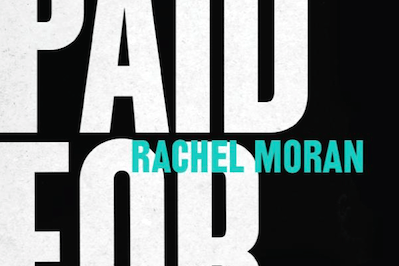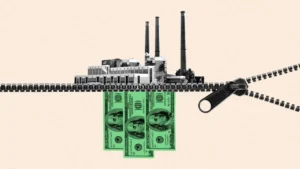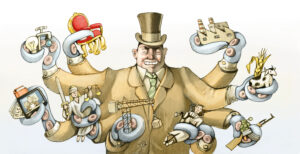Paid For
Rachel Moran, who spent seven years as a prostituted woman, explains in a book that is both excruciating memoir and brilliant political analysis, the real price that prostitution extracts from women turned into commodities under patriarchal capitalism. W. W. Norton & Company
W. W. Norton & Company
W. W. Norton & Company
“Paid For: My Journey Through Prostitution” A book by Rachel Moran
This is probably the best and worst of times to be asked to review “Paid For: My Journey Through Prostitution,” Rachel Moran’s brilliant book on what it means — on both the personal and political levels — to be paid for sex. The worst, because the most well-respected and well-known human rights organization in the world, Amnesty International, voted on Aug. 11, 2015, to support the decriminalization of all parties involved in sex transactions, including the person being prostituted, the person buying her, and the pimp. The best, because at a time when prostituted women have been so betrayed by the human rights movement, Moran — who spent seven years as a prostituted woman — explains, in excruciating clarity and detail, the real price that prostitution extracts from individual women, and from women as a subordinated class under patriarchal capitalism.
As I read Moran’s book, a quote kept coming to mind from the essay “Feminism: An Agenda,” written by Andrea Dworkin over 20 years ago. In the essay, Dworkin, writing at her best, forces us to confront how feminism is, at its root, about stopping male violence against women. She tells us that feminism, like all political movements, “is committed to the belief that there are certain kinds of pain that people should not have to endure.” Rachel Moran’s unflinching and brave account of her life in the sex industry in Ireland makes clear that the kinds of pain that are inherent in prostitution constitute a level of human rights abuse that is unquestionably beyond endurance. “Being abused,” Moran writes, “is not a right, human, civil, or otherwise.” How did Amnesty — and, indeed, all those who support the commodification and monetization of women’s and children’s bodies — manage to ignore this very simple fact?
Part of the answer lies in the way defenders of the sex industry want to complicate — or, in academic parlance, “problematicize” — the buying and selling of humans by dressing it up in neoliberal discourse. Invoking concepts such as choice, agency and empowerment serve to obfuscate what actually happens when a man pays for sex with a woman or child. Moran, all too familiar with the ways that prostitution is rebranded by the pro-sex lobby as an individual right and choice, speaks from experience when she says that “none of the social constructs is capable of eradicating the truth about prostitution and pornography as experienced by its participants. No amount of society looking the other way will ever erase the shame at the heart of sexual exploitation.”
The standard line of defense used by supporters of the sex industry is that those who oppose the buying of sex demean and dehumanize the women in the industry by ignoring their stories. We are told by these apologists to listen to the women who have been in the industry as a way to really understand the nature of prostitution. On this point I couldn’t agree more, and I implore all those who defend prostitution as “sex work” to read Rachel Moran’s book, because here is where you will find the truth about prostitution. You will find the truth in “Paid For” because Moran, unlike many sex industry spokespeople, was not paid by the sex industry to mouth the neoliberal party line that masks the political, economic and cultural institutions that give rise to prostituted sex. Instead, Moran writes:
“I never, ever came across a woman for whom selling her body caused her to be happy. Some of the consequences of having sold our bodies, the financial relief and the other forms of practical relief that came with that, were welcome; but that, as anyone with half a whit of sense knows, is not the same thing… choice and consent are erroneous concepts here. Their invalidity rests on the fact that a woman’s compliance in prostitution is a response to circumstances beyond her control, and this produces an environment which prohibits even the possibility of true consent. There is a difference between consent and reluctant submission. As lawyer and scholar Catharine MacKinnon says: ‘… when fear and despair produce acquiescence and acquiescence is taken to mean consent, consent is not a meaningful concept.’ ”
The problem with the pro-prostitution argument that prostituted women should be able to use their bodies as they choose is that “it is others who use the bodies of prostituted women as they so choose. That is the intention and the purpose and the function of prostitution.”
The only ones with any real choice in this market are the men doing the buying and the selling, so when prostitution is discussed in terms of a choice, it is the john, the pimp and the entire superstructure of patriarchy that gets to define the “truth” of prostitution.
In stark contrast to this false “truth,” Moran reveals the despair, trauma, poverty, pain and brutal violence that are not simply unfortunate byproducts of being prostituted but are, in fact, integral to the very nature of the transaction of a man buying sex from a woman or child. It would take a willful misreading of “Paid For” to argue that Moran’s story is a personal account of how a teenager ends up selling sex to survive. This book cannot be reduced to an individual story of how a teenage girl, because of family dysfunction and neglect, ends up poverty stricken, alone and at the mercy of a bevy of cruel predators who then exploit her subordinate position for their own sexual and economic gain.Moran begins the book by stating, “I have not written about prostitution with the sole focus on my own experience, because this issue is bigger than I am, and it is bigger than my place in it. My seven years in prostitution have brought me to the conviction that prostitution is also a collective, not a purely individual, experience.”
To explore this collective experience, this remarkable book unpeels, layer by layer, the macro systems of capitalism and patriarchy that intersect to create a nexus of institutions, dynamics and conditions that place an entire class of people — female — at risk of being prostituted. Capitalism sets the groundwork for the commodification of human bodies. Patriarchy sexualizes this commodification within gendered power relations such that it is the female body that will most likely be monetized.
And even as she is a brilliant political analyst, Moran is a powerful and disarmingly beautiful writer. She writes of her family and her mentally ill parents:
“Where does the fragmentation of a dysfunctional family begin? I believe it begins before the family does. I believe the wounds are already there, waiting to be cut into existence by the meeting of two unsuitable people and the birth of the children they go on to create with a love that is potent in its powers of destruction… my poor mother, with her untreated schizophrenia, was probably the one woman in all of Dublin who least fit the bill [to marry her manic depressive father]. But they did meet, they did marry, and the manifestations of my mother’s illness continued unabated and roared through her marriage and the childhoods of her children like the ocean in all of our ears.”
Moran finally left home — and became homeless — at the age of 14, when her mother became increasingly erratic and abusive after the death of Moran’s father. Of homelessness she writes:
“Not to be flippant, homelessness actually means sofalessness, chairlessness, tablelessness, TV-lessness, fridgelessness, cookerlessness, showerlessness (a dreadful condition) and, worst of all, bedlessness… When I became homeless, the first shock to me was the constant ceaseless need to remain in transit, and finding somewhere to simply be was a far bigger problem than I could have previously imagined. Nowhere you go are you left alone.”
Ironically,
“that brings me to the real and deepest damage of homelessness: the loneliness. It is the experience of being utterly unwanted, of your very presence being an undesirable commodity in all places and situations. Wherever you are, as a homeless person, you are unwelcome.”
Moran in the end never blames her parents, and in fact credits them with “the instinct for overcoming” that helped her eventually escape prostitution. It is one of many small touches of grace amidst deep despair in the book. Another is the memory of a girl not much older than herself handing Moran money, unasked for, when Moran was 14, homeless and trying to sleep huddled on a stone step one early morning:
“I remember watching her shiny chestnut hair as she walked down O’Connell Street, and I remember feeling a peculiar blend of shock and love. I waited till McDonald’s was open and bought myself some breakfast. That was over twenty years ago. The woman that girl became has most likely forgotten me. I have never forgotten her.”
So when a teenage girl is homeless and poor, what chance is there that her individual story will not play out the way Moran details it in “Paid For”? How could there have been a different ending, given that the well-oiled machinery of capitalist patriarchy has been operating for generations to keep the sex industry well supplied with girls and women who have been systematically robbed of choices that the privileged take for granted?
Moran, an astute scholar of how privilege works, makes sure to shine the spotlight on those who do indeed have choices. Her descriptions of johns reveal the underbelly of aggressive masculinity, and the emotional and sexual violence that defines the “relationship” between them and the women they pay for. Alongside the lie of the “Happy Hooker” image that the media perpetuates is the equally false image of the kindly john out to rescue the wayward woman. Think Richard Gere in “Pretty Woman,” with his charming ways and generous supply of money that finances Julia Roberts’ shopping sprees at designer stores. Or the rehabilitated john in “The Good Wife,” in which flashbacks show Chris Noth “making love” to prostituted women. Never once do we get a hint of how johns behave in the real world, and the hatred, contempt and cruelty that prostituted women experience on a regular basis.What Moran makes clear is that no matter where the john’s behavior falls along the continuum of sexual violence, prostitution, at its core, “is violence against women.” Moran writes:
“Prostitution and rape are commonly distinguished by the logical fact that to buy something and to steal something are two different things; but when we consider that the sex bought in prostitution is the same type of sex stolen in rape, sex that is, as Kathleen Barry puts it: ‘…disembodied, enacted on the bodies of women who, for the men, do not exist as human beings, and the men are always in control’ — it is then that we understand how deeply traumatising it is for the woman whose body is so used.”
Describing prostitution as “being raped for a living” and as the “commercialisation of sexual abuse,” Moran strips away both the Hollywood image of prostituted sex and the term “sex work” to reveal the ways that prostitution establishes and re-establishes men as the dominant class:
“Prostitution is essentially an issue that centres on the misuse of power — male power. It is universally accepted that those in command of greater fiscal resources are in a dominant position over those who are not, and the reality of women’s entry into prostitution due to financial hardship has been uncovered in prostitution research globally, in country after country after country, again and again and again. Therefore it is obvious that there is exploitation here. The exploitation element is indisputable, and the most succinct description of exploitation? An abuse of power.”
Yet Moran acknowledges that there are many prostituted women, her younger self included, who insist ferociously on the myth of their own control. It is, in fact, along with the technique of disassociation, one of the prostitute’s primary survival strategies:
“The mind is a complex and stubborn thing, and it believes what it needs to believe in order to navigate any difficult environment or circumstance… It was necessary for us to believe that we were in control because to accept that the opposite was true would have been to internalise the full awfulness of our present situation.”
To be effective, all systems of oppression demand a set of macro institutions that are buttressed by violent micro practices to remind the subordinated group just how powerless they are. Patriarchy’s most reliable tactic for terrorizing women into submission is both sexual violence and the threat of it. “Paid For” is laden with stories that illustrate the ways in which the johns use both violence and the threat of violence to the point that the very threat is as an ongoing policing mechanism. While Moran experienced — like all prostituted women — violence such as being slapped, punched or dragged around by the hair, to name just a few that she details, she explains that, in prostitution, “if anything is more pervasive than violence itself it is the threat of it.” The “past experience of violence acts as a guarantee of the legitimacy of all present and future threats… The threat of violence, therefore, is an act of psychological abuse; some conclude just as mentally damaging as physical violence itself.” In this way johns act collectively as terrorists, because each one draws power from the violence that the other johns have committed or threatened to commit.
Again, It would take a willful misreading of “Paid For” to argue that Moran’s story is a personal account of the johns she encountered and their individual sexual preferences. It is, instead, a cutting edge book that explains how the institution of prostitution exemplifies the way that a patriarchal society constructs masculinity as a brotherhood founded on violence, predatory sex and the systematic subordination of women.
“Paid For” also breaks new ground by dismantling the illusion of the sex industry as a collection of separate entities made up of stripping, prostitution and pornography. Moran shows how the sex industry is often experienced by women as a seamless combination of those elements as they are shuttled from strip clubs to brothels, hotels and porn sets. It is well known in the porn industry that many porn performers build a fan base by performing in strip clubs, but now, due in large part to the increase in the use of pirated porn scenes on porn tube sites, many performers have to turn to prostitution to make a living. In an October article in Slate, pornographer Mike South is quoted as saying that he used to be able to count on one hand the number of porn performers who did prostitution, and “now I can count the performers I know who don’t do it on one hand.”
Moran herself says that the different sectors of the sex industry “are not distinct industries: they are part of the same one big prostitution machine, a mechanism which actively reduces the worth of women and does so by placing their commodification both at its apex and at its core.” This analysis by Moran, now one of the leading activists in the world mobilizing against the sex industry, is a call to all of us to understand and act on the interconnectedness of all aspects of commercial sexual exploitation.Moran also examines the “normalisation” of prostitution in mainstream culture, and its widespread acceptance, or at least tolerance, by both genders. But this, Moran warns us, is a dangerous road:
“Non-prostituted women, many of them, have been schooled to accept prostitution along with pornography as something they dare not oppose as offensive for fear of being labeled frigid-minded prudes… If a woman tolerates this treatment of her fellow women, if she accepts it under the banner of ‘liberalism’ or anything else, then she must also accept that she herself is only removed from prostitution by lack of the circumstances necessary to place her there… The acceptance of prostitution makes all women potential prostitutes in the public view since there are only two requirements for a woman to work in a brothel: one is that circumstance has placed her so (and who knows when that can happen, to any of us?) and the other is that she has a vagina, and all women are born meeting at least one of these requirements.”
As for men, “tolerance of prostitution clearly cannot exist in any man until he has formed the view that the commodification of women is tolerable.”
Moran did not write this book for the sole purpose of explaining how prostitution is a form of sexual slavery, although she has done a great service to women everywhere by making this apparent. She has written this book — which demonstrates her tremendous courage as a survivor, as well as putting her at great personal risk as an activist — to unmask how the neoliberal analysis of the sex industry renders invisible the fact that patriarchal capitalism and male violence against women undergird the entire infrastructure of the sex industry.
By doing this, she obliterates the simplistic notions that women end up in the industry by choice, that consumers are merely boys being boys, and that the solution to ending sexual slavery is to legalize it. In place of mindlessly worshiping the sovereignty of the individual, which is the religion of neoliberalism, Moran forces us to go back to the essential core of feminist thinking: The personal is political.
This book, which documents the personal journey of Rachel Moran through prostitution, is a rich and deep analysis of the political nature of women’s lives within a patriarchal structure that is founded on, and dedicated to, the subordination of Rachel Moran and all her sisters. That the leading human rights organization in the world has now been folded into this structure should be enough to galvanize every woman on the planet to fight back. As Moran says, “To be prostituted is humiliating enough; to legalise prostitution is to condone that humiliation and to absolve those who inflict it. It is an agonising insult.” The only thing I can add is that this humiliation and agony must end. Who better to end it than a feminist movement that gave birth to women like Rachel Moran and Andrea Dworkin, who fought for the simple but revolutionary idea that women should not have to endure male violence?
Gail Dines is a professor of sociology and women’s studies at Wheelock College, and author of “Pornland: How Porn Has Hijacked Our Sexuality.” She is the founding chair of Culture Reframed, a feminist nonprofit health education organization.
Your support matters…Independent journalism is under threat and overshadowed by heavily funded mainstream media.
You can help level the playing field. Become a member.
Your tax-deductible contribution keeps us digging beneath the headlines to give you thought-provoking, investigative reporting and analysis that unearths what's really happening- without compromise.
Give today to support our courageous, independent journalists.






You need to be a supporter to comment.
There are currently no responses to this article.
Be the first to respond.